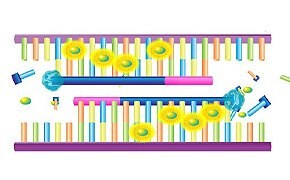Quantitative PCR (qPCR)

Quantitative Real-Time PCR (qPCR) uses fluorescent reporter molecules to allow quantification of amplified products. As in conventional PCR, a DNA, cDNA, or RNA template is amplified, but at each cycle, fluorescent signals are monitored for relative or absolute quantification. This technique is useful for numerous areas of research including gene expression analysis, genotyping, microRNA analysis, genetic variation analysis, and protein analysis.
How to Analyze qPCR Data
The fluorescence of the reporter molecules is measured and quantified; typically these are either dyes (i.e. SYBR® Green, Ethidium Bromide) that intercalate between the bases in double-stranded DNA, or probes designed to bind a specific sequence (i.e. Molecular Beacons, TaqMan® probes) on the DNA.
Relative Quantitation of qPCR Data
There are two major quantification methods for qPCR data. Relative quantification, the more common method, uses ΔΔCt information, by which the expression or abundance ratio of the target gene in the sample is determined, compared to a control gene, and normalized with the expression ratio of a reference gene. Since, the efficiency E values for target and reference genes differ, this method also accounts for the differences in E values. This method is more frequently employed in gene expression analysis.
Absolute Quantitation of qPCR Data
The second method, absolute quantification, is more common in environmental microbiology and makes use of the standard-curve (SC). The SC method uses dilution series of known template concentration, N0, to create a standard curve using the linear regression of log(N0) versus the CT (threshold cycle). This is then used to calculate template concentrations of the sample. The basis of this method is that the efficiency value of the sample is the same as that of the standard.
Related Technical Articles
- After a traditional PCR has been completed, the PCR/qPCR data analysis is conducted by resolution through an agarose gel or, more recently, through a capillary.
- Real-time polymerase chain reaction allows researchers to estimate the quantity of starting material in a sample. It has a much wider dynamic range of analysis than conventional PCR
- PCR assay guide navigates you through primer validation and other assay optimization factors to ensure high sensitivity and specificity for optimum DNA/ RNA quantification.
- The entire PCR workflow is vulnerable to factors which introduce variability. Many of the variable components are unavoidable, such as the source of the sample or the requirement for a reverse transcription step. Assay design is also highly variable and can make the difference between PCR success and failure and also contributes to the reproducibility and sensitivity of an assay.
- Dual-Labeled Probes are the most common probe type for qPCR and are often referred to as hydrolysis probes.
- See All
Related Protocols
- Our SYBR Green qPCR Protocol is a method designed to detect accurate quantification of gene expression and RT-PCR reactions
- Chromatin Immunoprecipitation quantitative real-time PCR (ChIP-qPCR) is commonly used in studies that focus on specific genes and potential regulatory regions across differing experimental conditions and data analysis. qPCR enables DNA analysis in real time by analyzing fluorescent signal intensities that are proportional to the amount of amplicon.
- Primer Concentration Optimization Protocol is an approach to create a matrix of reactions. This is used to test a range of concentrations for each primer against different concentrations of the partner primer.
- Once an assay has been optimized, it is important to verify the reaction efficiency. This information is important when reporting and comparing assays. In this example protocol, the assay efficiency is compared over a wide and narrow dynamic range of cDNA concentrations.
- Multiplex qPCR employing probe-based chemistries is a demanding application that often requires extensive optimization and validation.
- See All
To continue reading please sign in or create an account.
Don't Have An Account?